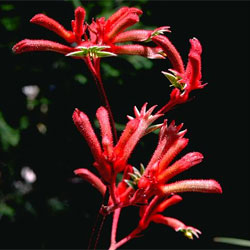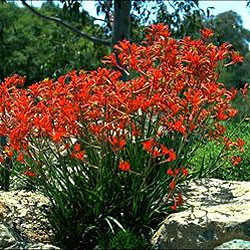Anigozanthos 'Dwarf Delight'
 |
 |
Anigozanthos 'Dwarf Delight' nom. cult.
Plants of the singularly arresting genus Anigozanthos, more commonly known as the Kangaroo Paws, have become widely recognised in horticulture as ornamentals and for their use in the cut flower trade. They are a group of perennial plants from Western Australia which have strap-shaped leaves and rhizomes.
Anigozanthos, which belongs to the family Haemodoraceae and related to the Liliaceae, includes eleven species. All are restricted to the southwest corner of Western Australia ranging from north of Geraldton on the west coast to east of Esperance on the south coast.
The unique flowers are tubular and occur in colours of yellow to orange, red and green. Several flowers are grouped together at the end of long stems and, with their 5 protruding stamens, each looks like the paw of a kangaroo. Both flowers and stamens are clothed with velvety hairs. It is a delightful experience to watch honeyeating birds feeding on these plants. A very effective method of pollen exchange occurs as they plunge their beaks into the flowers to reach the nectar. As they brush past the protruding stamens they are dusted with pollen which they transfer to other flowers they visit. Honey-eaters may often be seen with yellow patches of pollen on their heads.
There are several outstanding Anigozanthos hybrids. The registered cultivar Anigozanthos 'Dwarf Delight' resulted from a cross between A. onycis and A. flavidus and bears some of the characteristics of both parents. It is a compact plant to 0.8 m tall with much branched flowering stems. These are covered with reddish hairs as are the greenish-yellow flowers, giving an overall impression of rich red flowers and stems. The strap-shaped leaves are up to 250 mm long by 10 mm wide.
This delightful plant is free-flowering and provides a bright splash of colour in the garden landscape particularly if planted in a rockery or when used as a border or tub plant. It shows excellent qualities for use in the cut flower trade because of its long stems and attractively coloured velvety flowers. As a vase plant the flowers can last from two to four weeks.
Problems have been experienced with a fungal disease known as 'ink spot' which affects the foliage of Anigozanthos. Attempts to eliminate this problem by hybridisation and tissue culture are giving positive results. Anigozanthos'Dwarf Delight' appears to be less prone to 'ink spot' and is easily propagated by division of the rhizomes or by tissue culture.
It will grow in most soils in a well-drained sunny position but requires protection from snails when young. An application of a complete fertiliser in autumn and spring will keep the plants healthy. Old leaves and flowering stems should be removed and it is advisable to lift the plants and divide them every two or three years.
Text by Effie Mullins, ANBG (1989)
Name meaning: AnigozanthosAnigozanthos - probably derived from the Greek anises, meaning 'unequal' or 'oblique', and anthos, meaning 'flower', in reference to the division of the floral extremities into six unequal parts. |
![An Australian Government Initiative [logo]](/images/austgovt_brown_90px.gif)

